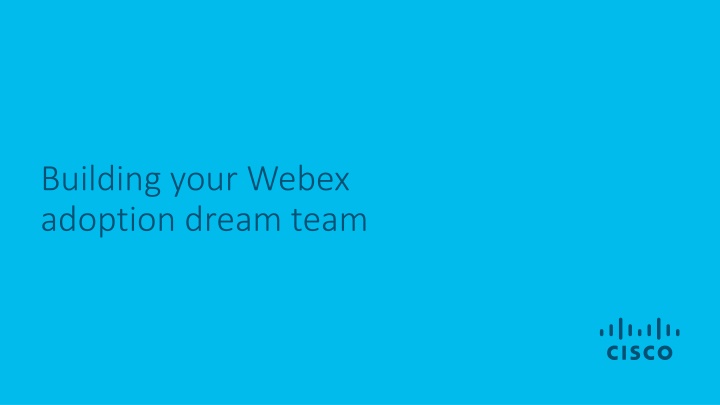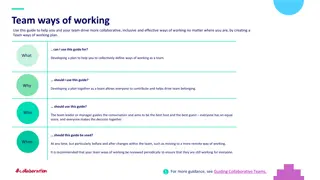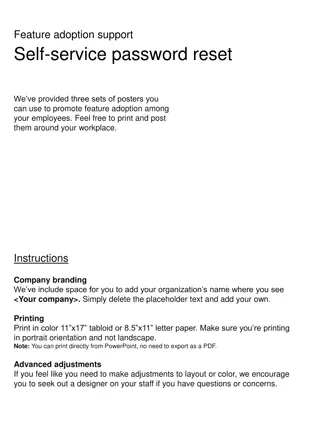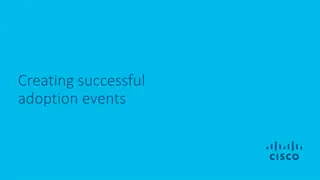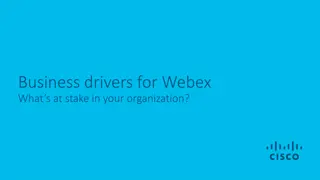Building Your Webex Adoption Dream Team - Essential Guide for Success
Adoption projects require continual monitoring and attention to ensure success. Learn about project governance, core team roles, and their responsibilities to drive successful Webex adoption. Find guidance on selecting a cross-functional team, focusing on business outcomes, and maintaining effective communication and leadership. Key topics include governance importance, typical team structure, and the significance of project governance for successful adoption.
Download Presentation

Please find below an Image/Link to download the presentation.
The content on the website is provided AS IS for your information and personal use only. It may not be sold, licensed, or shared on other websites without obtaining consent from the author.If you encounter any issues during the download, it is possible that the publisher has removed the file from their server.
You are allowed to download the files provided on this website for personal or commercial use, subject to the condition that they are used lawfully. All files are the property of their respective owners.
The content on the website is provided AS IS for your information and personal use only. It may not be sold, licensed, or shared on other websites without obtaining consent from the author.
E N D
Presentation Transcript
Building your Webex adoption dream team
Building your Webex adoption dream team Adoption projects are not just planned and set in motion, they require continual monitoring to keep them on track and focused on successful business outcomes. Contents include: An example organizational chart Within this pack you will find guidance on how to select a cross-functional project team that can tackle the Five Pillars of Success. Adoption projects are not just planned and set in motion, they require continual attention and monitoring to keep them on track and focused on the business outcomes you re aiming for. An explanation of governance and why it's important to get right A typical team set up and their responsibilities This means setting up a cross-functional project team that can tackle the Five Pillars of Success it s not all about IT. You also need expertise in communications, learning and development, leadership, and more. An example meeting agenda Extra help and support links Good project governance isn t easy, it takes discipline, but effective governance ensures projects deliver the value expected of them. Which ensures that customers will renew contracts and your accounts will grow.
This graphic shows a typical project governance structure for a Webex deployment Executive sponsor Core team Technical lead / Service owner Project manager Comms lead Training lead CSM Extended team Line of business (LOB) reps Business analyst Champions and influencers HR rep Legal rep Brand lead Intranet rep
What is project governance and do we need it? Good project governance is your insurance policy for adoption success Adoption projects are not just planned and set in motion, they require continual attention and monitoring to keep them on track and focussed on the business outcomes you re aiming for. This means setting up a cross-functional project team that can tackle the Five Pillars of Success. It s not all about IT, you also need expertise in communications, learning and development, leadership, and more. Team size will vary depending on your company size and scope of the Webex deployment, but all core roles need to be covered, even if not full time. Regular meetings are essential to keep everyone on track and working towards the same goals.
Typical roles and responsibilities Here are the essential members of the core team Your core team Supporting your core team Executive sponsor Win support, buy-in, and strategic direction from the top of the organization. They will articulate why Webex is important to the organization. Cisco customer success manager (CSM). Your Cisco adoption specialist who will guide you to success and connect you with the experts and content you need to make progress. Communications lead Plan and execute a multichannel communication strategy to create buzz and drive engagement. Sell the value proposition and promote use cases. Technical lead / Service owner Create employee accounts and integrate with identity provider/SSO (if applicable). Make sure the service works first and every time. Simplify processes with bots and integrations. Training lead Gather / create self-service learning like quick start and how-to guides. Provide coaching, training, and encouragement to employees. Project manager Responsible for the end-to-end project change management. Coordinates all other resources during implementation.
The team Extended team Several other roles can support the core team. For smaller scale Webex deployments, the core team can often manage on their own, but larger deployments are likely to require additional expertise. Line of business (LOB) reps Advise on the high value use cases to lead with. Knows who needs Webex the most and which workflows it can improve. (Like sales, marketing, engineering, etc.) Business analyst Complex analysis and reporting on adoption and business impact. Intranet lead Advise on how self-learning content and comms can be published and maintained. HR rep Advise on a wide range of policy issues, from working from home to country-specific regulation, and employment law. Champions and influencers Spread best practice and help other employees adopt Webex. Be the eyes and ears of the project team and provide valuable feedback. Legal representative Advise on corporate requirements, legal copy, and other compliance matters. Brand lead Advise on customization and branding of content and communication materials.
An example meeting agenda Your Kick off meeting is the perfect place to start putting together your dream team and assigning tasks and responsibilities to your project team. Here is a typical kick off meeting agenda 1. Welcome and introductions Who s working on the project and what s their role? Pillar 1: Leadership Have all the key stakeholders been identified and included? How involved will each person be a quick RACI (Responsible, Accountable, Consulted, Informed) matrix is always a good idea here. Pillar 5: Champions Is there an established network of advocates for the Webex deployment? People who have volunteered to help others get started? Discuss how to identify, select and support champions? We have written some handy guidance on this which you can find here. 2. Review business drivers / business case This could be a deep review of the reasons for choosing Webex and what the goal is for the business or an opportunity to recap, reinforce and reignite those business drivers. Pillar 2: Technical Readiness Review current position, highlighting any challenges or concerns, timelines and milestones. 4. Success indicators and measurement targets What are the key metrics or success factors? And how will we measure them? Do we have the right reporting or feedback capture mechanisms? Pillar 3: Use Cases Identify priority use cases time allowing, a use case workshop can be a great addition. At a minimum, discuss some of the line of business use cases from the Webex playbooks. 3. How does Webex fit into the companies broader digital strategy? Are there other concurrent projects or business / organisational changes that may have impact on the strategy. 5. Next steps: Agree follow up actions and owners Schedule regular follow meetings or check-ins Pillar 4: Communication Planning Review existing communication plans or Start to identify communication channels, opportunities and mechanisms in preparation for creating a communications plan.
Additional resources We have created several other resources to help you on your way to Webex success Use Cases Leadership Communications Champions Technical Readiness Business drivers The 5 pillars of success Measurements and targets Guidance and worksheet for identifying your underlying business drivers for choosing Webex and focusing all of your efforts on achieving them. The Pillars will guide you through everything from launch and implementation plans to ongoing management, communications and stakeholder engagement. They ll also equip you with the right structure and considerations to manage your own implementation or adoption drive. So you ve defined your business drivers and planned for high adoption using the pillars of success. But how will you know how well things are going once you ve put the plan into action? Before you roll out the services, you must also set some targets and measures for success. This will help you make tactical changes when adoption is lower than expected, and also demonstrate return on investment (ROI).
